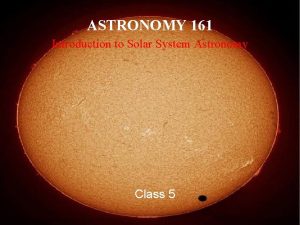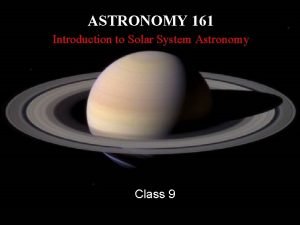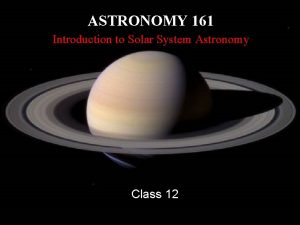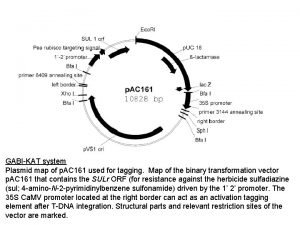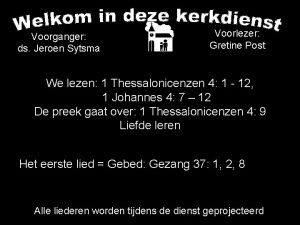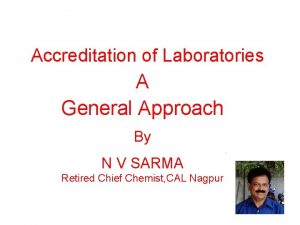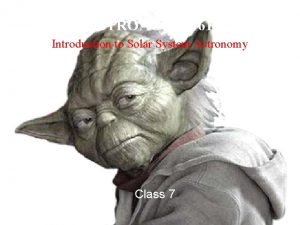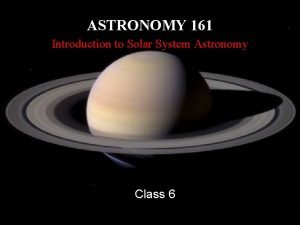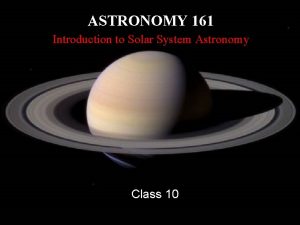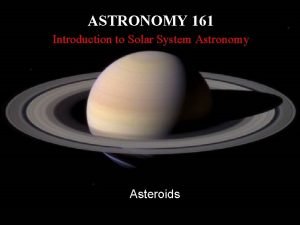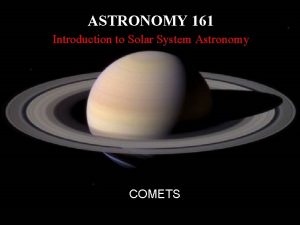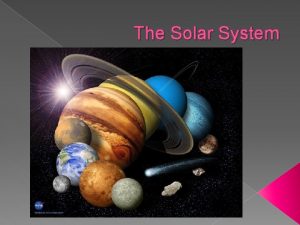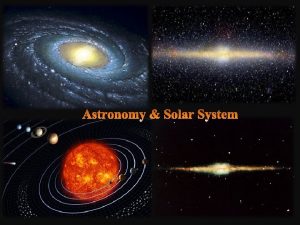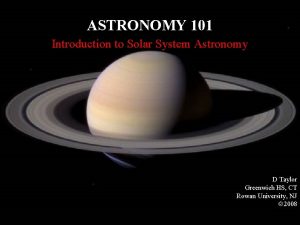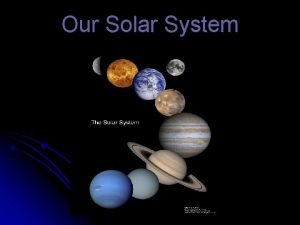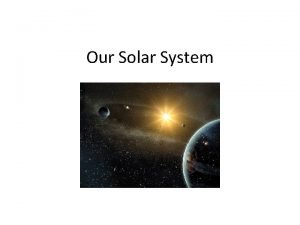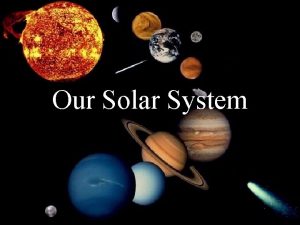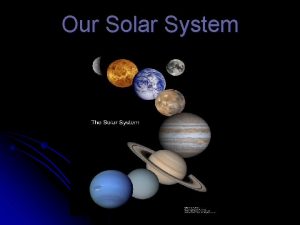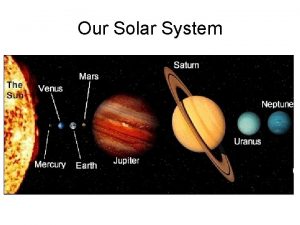ASTRONOMY 161 Introduction to Solar System Astronomy Class
































- Slides: 32

ASTRONOMY 161 Introduction to Solar System Astronomy Class 16

Earth’s Atmosphere Monday, February 19




Earth’s Atmosphere: Key Concepts (1) The Earth’s atmosphere consists mainly of nitrogen (N 2) and oxygen (O 2). (2) Without life, air would have no O 2; without oceans, it would have more CO 2. (3) The ozone (O 3) layer has been partially destroyed by chlorofluorocarbons. (4) Excess CO 2 can cause global warming via the greenhouse effect.

(1) The Earth’s atmosphere consists mainly of nitrogen and oxygen. The Earth’s Atmosphere: List of Ingredients Gas Percent of total mass nitrogen (N 2) 78% oxygen (O 2) 21% everything else 1%

Air pressure decreases with altitude Air pressure at sea level = 15 pounds per square inch. Pressure drops by 50% for every 5. 5 km (18, 000 feet) in altitude. (Atop Everest, pressure is 1/3 its value at sea level. ) No sharp upper cutoff to atmosphere.

The Earth’s atmosphere is differentiated into layers. Pressure decreases as you go up. Density decreases as you go up. Temperature varies.

The layers. Troposphere (0 -12 km): Temperature decreases with height. Stratosphere (12 -50 km): Temperature increases with height. (Warm because the ozone layer absorbs ultraviolet light. ) Mesosphere (50 -80 km): Temperature decreases with height. Thermosphere (80 km - ? ? ? ): temperature increase with height. (Warm because it absorbs X-rays. )


The Earth’s atmosphere differs from those of Venus and Mars. Venus: very dense atmosphere, 96% carbon dioxide (CO 2). Mars: low-density atmosphere, 95% CO 2. Earth: moderate atmosphere, 0. 04% CO 2. Why so little CO 2?

The oddity of oxygen. The significant presence of oxygen (O 2) in the air is highly unusual. Oxygen combines readily with carbon and hydrogen (“burning”) and with iron (“rusting”). Why so much O 2?

(2) Without life, air would have no O 2; without oceans, it would have more CO 2. Early atmosphere of Earth: CO 2, N 2, H 20. As Earth cooled from its molten state, H 20 rained down to form oceans. CO 2 dissolved in oceans, then precipitated out as carbonates (such as limestone). CO 2 is locked up in rocks.

About 3. 5 billion years ago, photosynthetic organisms started pumping O 2. A fossilized colony of “cyanobacteria” (bluegreen algae), about 3. 5 billion years old.

Eventually, oxygen (O 2) accumulated; ozone (O 3) formed in the stratosphere, absorbing ultraviolet light and permitting life on land. O 2 is constantly replenished by plants.

(3) The ozone layer has been partially destroyed by chlorofluorocarbons. Ozone layer: The region in the stratosphere, about 25 kilometers up, where ozone (O 3) is concentrated.

Ozone absorbs ultraviolet light: O 3 + photon O 2 + O + heat

Every spring, natural processes deplete the ozone layer over Antarctica, creating a “hole”. In recent years, the ozone hole has been larger and longer-lived.

Ozone depletion is not restricted to Antarctica. The ozone layer over Switzerland thinned noticeably after 1970.

Prime suspects for ozone destruction: Chlorofluorocarbons (CFCs). “Freon” is a type of CFC: CFCs drift to the ozone layer and catalyze the destruction of ozone: CFC + O 3 CFC + O 2 + O + heat

The use of CFCs has been phased out: Montreal Protocol on Substances That Deplete the Ozone Layer: international treaty designed to protect the ozone layer by phasing out a number of substances responsible for ozone depletion. The treaty was entered into force in 1989. Due to its widespread adoption and implementation it has been hailed as an example of exceptional international cooperation. Kofi Annan is quoted as saying it is "Perhaps the single most successful international agreement to

(4) Excess CO 2 can cause global warming via the greenhouse effect. Greenhouse Effect: Visible light enters atmosphere and warms the Earth’s surface. Surface emits infrared light, which is trapped by atmosphere.

“Greenhouse gases” Transparent to visible light, opaque to infrared light. 1) Carbon dioxide (CO 2) 2) Methane (CH 4) 3) Water vapor (H 20) 4) Nitrous oxide (N 20) All these gases are naturally present in the Earth’s atmosphere.

An average day on Earth Temperature WITH greenhouse: 282 Kelvin (48 o F) Temperature WITHOUT greenhouse: 246 Kelvin (-17 o F) Presence of greenhouse gases is a very significant factor for Earth’s average temperatures.

The burning of fossil fuels (and rapid deforestation) is raising the level of CO 2. AD 1800: 280 parts per million AD 2006: 380 p. p. m.

Estimate: Average temperature has risen 0. 6 degrees (Celsius) since 1860.

Even a fairly small temperature rise might cause a change in sea level, by melting icecaps.


Production of CFCs has been stopped, but ozone will take decades to recover. Burning of fossil fuels continues.

Burning of fossil fuels continues

Few closing questions: 1) What is the main difference between the atmospheres of Earth and Venus? 2) If the polar icecaps have melted completely, how much would the sea level raise?
 Solar system astronomy class
Solar system astronomy class Solar system astronomy class
Solar system astronomy class Solar system astronomy class
Solar system astronomy class Astronomy 161
Astronomy 161 Learning astronomy by doing astronomy activity 1 answers
Learning astronomy by doing astronomy activity 1 answers Learning astronomy by doing astronomy answers
Learning astronomy by doing astronomy answers Learning astronomy by doing astronomy
Learning astronomy by doing astronomy Solar panel wholesale
Solar panel wholesale Solar energy is free. solar is inexhaustible
Solar energy is free. solar is inexhaustible Psalm 96 2-3
Psalm 96 2-3 Gezang 161
Gezang 161 Mini vidas parts
Mini vidas parts Port 161
Port 161 Gezang 161
Gezang 161 Convenio 161 oit resumen
Convenio 161 oit resumen Ucr cs 161
Ucr cs 161 Computer security 161 cryptocurrency lecture
Computer security 161 cryptocurrency lecture Jelena đorđevic 161
Jelena đorđevic 161 Inls 161
Inls 161 Computer science 161
Computer science 161 Mcp 161
Mcp 161 Glosf
Glosf Pa 161 program
Pa 161 program Gabikat
Gabikat Error 161
Error 161 Drba-161
Drba-161 Csc 161 rochester
Csc 161 rochester Xdbx debugger
Xdbx debugger Bvp 161
Bvp 161 Frank roorda
Frank roorda Jeroen sytsma
Jeroen sytsma 160 161
160 161 Clinical pathology laboratories
Clinical pathology laboratories
